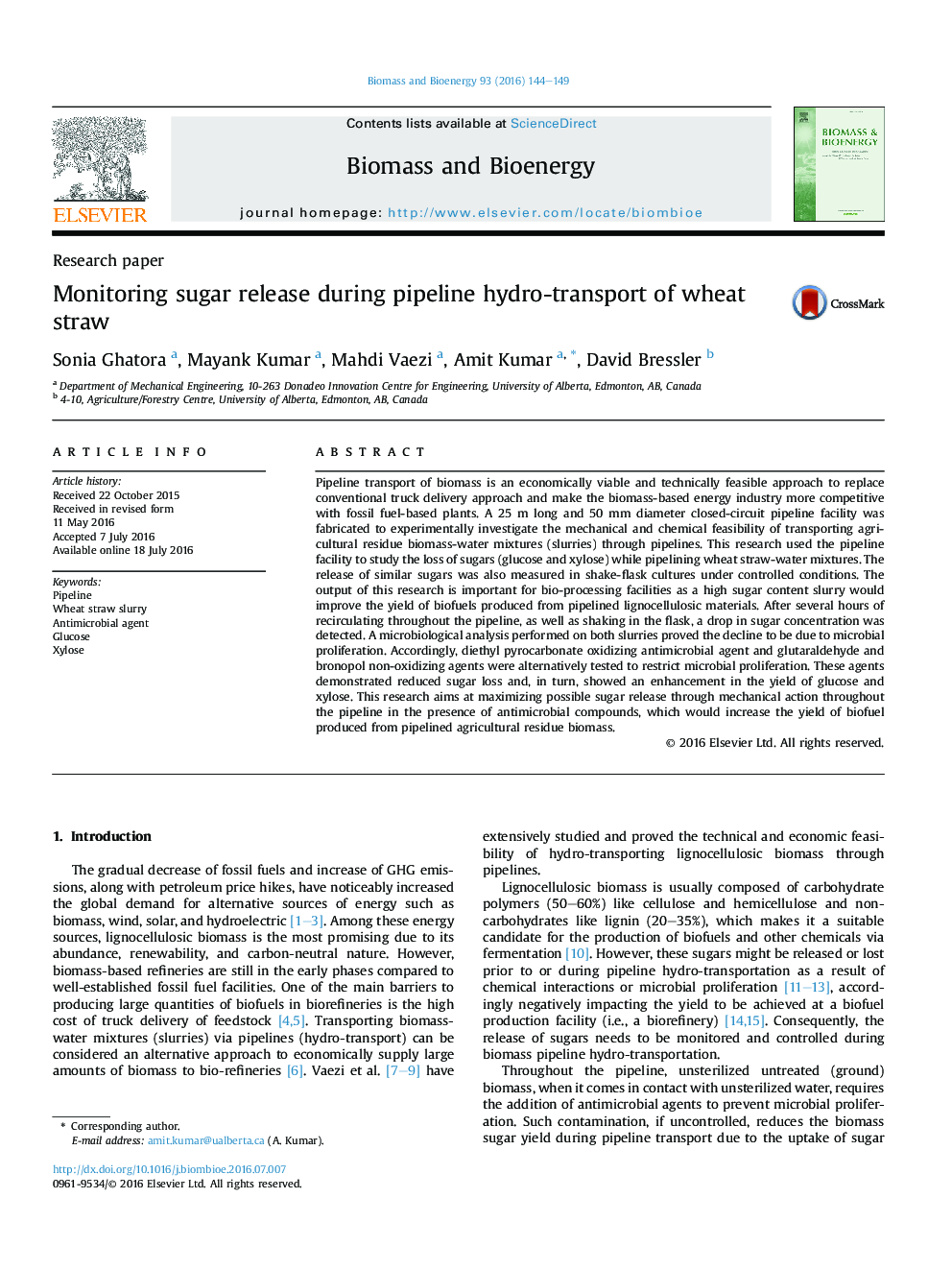| کد مقاله | کد نشریه | سال انتشار | مقاله انگلیسی | نسخه تمام متن |
|---|---|---|---|---|
| 7063182 | 1459800 | 2016 | 6 صفحه PDF | دانلود رایگان |
عنوان انگلیسی مقاله ISI
Monitoring sugar release during pipeline hydro-transport of wheat straw
ترجمه فارسی عنوان
نظارت بر تولید شکر در طی حمل و نقل هیدرولیکی از کاه گندم
دانلود مقاله + سفارش ترجمه
دانلود مقاله ISI انگلیسی
رایگان برای ایرانیان
کلمات کلیدی
خط لوله، دوغاب کاه گندم، عامل ضد میکروب، گلوکز، زایلوز،
ترجمه چکیده
حمل و نقل خط لوله زیست توده یک رویکرد اقتصادی قابل قبول و فنی قابل اجرا برای جایگزینی روش معمول حمل و نقل کامیون است و صنعت انرژی بر پایه زیست توده را با گیاهان مبتنی بر سوخت فسیلی رقابت می کند. یک قطعه 25 الی 20 میلی متر طول و 50 الی 30 میلیمتر قطر قطر لوله قطعه قطعه قطعه قطعه شده برای آزمایش آزمایشی امکان سنجی امکان دستیابی به مخلوط های زیست توده و آب زباله های کشاورزی از طریق خط لوله را بررسی کرد. در این تحقیق از لوله نهایی برای مطالعه از دست دادن قندها (گلوکز و زایلوز) در هنگام استفاده از مخلوط های آب و فاضلاب گندم استفاده شد. انتشار قندهای مشابه نیز در کشت های لرزش فلاسک تحت شرایط کنترل شده اندازه گیری شد. خروجی این تحقیق برای تاسیسات زیست محیطی مهم است به عنوان یک مخلوط حاوی مقادیر بالای قند، باعث بهبود عملکرد سوخت های زیستی تولید شده از مواد لیگنوسلولیزه شده از طریق خط لوله می شود. بعد از چندین ساعت در طول خط لوله، و نیز تکان دادن در فلاسک، کاهش غلظت قند مشخص شد. تجزیه و تحلیل میکروبیولوژیکی بر روی هر دو ماده خشک نشان داد که کاهش ناشی از تکثیر میکروبی است. به همین ترتیب، عامل ضد میکروبی اکسید کننده دی اتیل پریکو کربنات و عوامل غیر اکسید کننده گلوتارالدئید و برونوپول به طور متناوب مورد آزمایش قرار گرفت تا مانع تکثیر میکروبی شود. این عوامل باعث کاهش میزان قند شده و به نوبه خود افزایش عملکرد گلوکز و زایلوز را نشان می دهد. هدف از این تحقیق، به حداکثر رساندن امکان آزاد سازی قند از طریق اقدام مکانیکی در طول خط لوله در حضور ترکیبات ضد میکروبی است که باعث افزایش تولید سوخت های زیستی تولید شده از زیست توده باقیمانده کشاورزی می شود.
موضوعات مرتبط
مهندسی و علوم پایه
مهندسی شیمی
تکنولوژی و شیمی فرآیندی
چکیده انگلیسی
Pipeline transport of biomass is an economically viable and technically feasible approach to replace conventional truck delivery approach and make the biomass-based energy industry more competitive with fossil fuel-based plants. A 25Â m long and 50Â mm diameter closed-circuit pipeline facility was fabricated to experimentally investigate the mechanical and chemical feasibility of transporting agricultural residue biomass-water mixtures (slurries) through pipelines. This research used the pipeline facility to study the loss of sugars (glucose and xylose) while pipelining wheat straw-water mixtures. The release of similar sugars was also measured in shake-flask cultures under controlled conditions. The output of this research is important for bio-processing facilities as a high sugar content slurry would improve the yield of biofuels produced from pipelined lignocellulosic materials. After several hours of recirculating throughout the pipeline, as well as shaking in the flask, a drop in sugar concentration was detected. A microbiological analysis performed on both slurries proved the decline to be due to microbial proliferation. Accordingly, diethyl pyrocarbonate oxidizing antimicrobial agent and glutaraldehyde and bronopol non-oxidizing agents were alternatively tested to restrict microbial proliferation. These agents demonstrated reduced sugar loss and, in turn, showed an enhancement in the yield of glucose and xylose. This research aims at maximizing possible sugar release through mechanical action throughout the pipeline in the presence of antimicrobial compounds, which would increase the yield of biofuel produced from pipelined agricultural residue biomass.
ناشر
Database: Elsevier - ScienceDirect (ساینس دایرکت)
Journal: Biomass and Bioenergy - Volume 93, October 2016, Pages 144-149
Journal: Biomass and Bioenergy - Volume 93, October 2016, Pages 144-149
نویسندگان
Sonia Ghatora, Mayank Kumar, Mahdi Vaezi, Amit Kumar, David Bressler,
